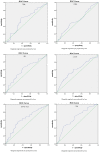Prognostic value of preoperative serum bilirubin levels in ovarian cancer
- PMID: 32509218
- PMCID: PMC7269994
Prognostic value of preoperative serum bilirubin levels in ovarian cancer
Abstract
Bilirubin is a promising prognostic factor for non-liver disease-related deaths in various cancers. We investigated the association between preoperative serum bilirubin levels and oncological outcomes in patients with ovarian cancer. We retrospectively analyzed the clinical data of 282 patients with epithelial ovarian carcinoma (EOC), and grouped them according to optimal threshold values of total bilirubin (TBIL), direct bilirubin (DBIL), and indirect bilirubin (IBL) measured by receiver operating characteristic curve analysis. Univariate and multivariate Cox proportional hazards regression analyses were used to evaluate various parameters that might affect overall survival (OS) and progression-free survival (PFS) in patients with EOC. The optimal cutoff values for TBIL, DBIL, and IBIL levels were 9.65 µmol/L, 2.95 µmol/L, and 6.75 µmol/L, respectively. Increased TBIL, DBIL, and IBIL levels correlated with the serum carbohydrate antigen (CA)-125 levels, International Federation of Gynecology and Obstetrics stage, and pathological differentiation (all P<0.05). Univariate analysis revealed longer OS and PFS in patients with high TBIL (≥9.65 µmol/L) and IBIL (≥6.75 µmol/L) levels (P<0.05). Multivariate analysis showed that patients with high IBIL levels (≥6.75 µmol/L) had significantly longer OS and PFS than those with low IBIL levels (<6.75 µmol/L) [hazard ratio (HR) = 0.333, 95% confidence interval (CI): 0.123~0.904, P<0.05; HR = 1.814, 95% CI: 1.169~2.816, P<0.05]. Therefore, IBIL is a potential independent prognostic factor for OS and PFS in patients with EOC. The higher the IBL level, the better the prognosis of patients with EOC.
Keywords: Bilirubin; epithelial ovarian carcinoma; overall survival; prognosis; progression-free survival.
AJTR Copyright © 2020.
Conflict of interest statement
None.
Figures


Similar articles
-
Elevated serum bilirubin levels are associated with improved survival in patients with curatively resected non-small-cell lung cancer.Cancer Epidemiol. 2015 Oct;39(5):763-8. doi: 10.1016/j.canep.2015.06.007. Epub 2015 Jul 7. Cancer Epidemiol. 2015. PMID: 26159684
-
Prognostic value of serum bilirubin in southern Chinese patients with advanced nasopharyngeal carcinoma.Clin Chim Acta. 2018 Sep;484:314-319. doi: 10.1016/j.cca.2018.05.058. Epub 2018 May 31. Clin Chim Acta. 2018. PMID: 29860034
-
Indirect bilirubin impairs invasion of osteosarcoma cells via inhibiting the PI3K/AKT/MMP-2 signaling pathway by suppressing intracellular ROS.J Bone Oncol. 2023 Feb 23;39:100472. doi: 10.1016/j.jbo.2023.100472. eCollection 2023 Apr. J Bone Oncol. 2023. PMID: 36876225 Free PMC article.
-
Association of Serum Bilirubin With Metabolic Syndrome and Non-Alcoholic Fatty Liver Disease: A Systematic Review and Meta-Analysis.Front Endocrinol (Lausanne). 2022 Jul 20;13:869579. doi: 10.3389/fendo.2022.869579. eCollection 2022. Front Endocrinol (Lausanne). 2022. PMID: 35937795 Free PMC article.
-
Dietary vitamin D equilibrium in serum ameliorates direct bilirubin associated diabetes mellitus.Chem Biol Interact. 2021 Mar 1;337:109399. doi: 10.1016/j.cbi.2021.109399. Epub 2021 Jan 24. Chem Biol Interact. 2021. PMID: 33503443 Review.
Cited by
-
Bilirubin as a metabolic hormone: the physiological relevance of low levels.Am J Physiol Endocrinol Metab. 2021 Feb 1;320(2):E191-E207. doi: 10.1152/ajpendo.00405.2020. Epub 2020 Dec 7. Am J Physiol Endocrinol Metab. 2021. PMID: 33284088 Free PMC article. Review.
-
AI models predicting breast cancer distant metastasis using LightGBM with clinical blood markers and ultrasound maximum diameter.Sci Rep. 2024 Jul 6;14(1):15561. doi: 10.1038/s41598-024-66658-x. Sci Rep. 2024. PMID: 38969798 Free PMC article.
-
Association of Pretreatment Serum Indirect Bilirubin Levels With Prognostic and Therapeutic Value in Patients With Newly Diagnosed Acute Myeloid Leukemia.Cancer Med. 2025 Feb;14(3):e70572. doi: 10.1002/cam4.70572. Cancer Med. 2025. PMID: 39868887 Free PMC article.
-
Bilirubin - new insights into an old molecule.Biochem Med (Zagreb). 2025 Jun 15;35(2):020501. doi: 10.11613/BM.2025.020501. Epub 2025 Apr 15. Biochem Med (Zagreb). 2025. PMID: 40469572 Free PMC article. Review.
-
Predictive value of indirect bilirubin before neoadjuvant chemoradiotherapy in evaluating prognosis of local advanced rectal cancer patients.World J Gastrointest Oncol. 2022 Nov 15;14(11):2224-2237. doi: 10.4251/wjgo.v14.i11.2224. World J Gastrointest Oncol. 2022. PMID: 36438711 Free PMC article.
References
-
- Kumar S, Long J, Kehoe S, Sundar S, Cummins C. Quality of life outcomes following surgery for advanced ovarian cancer: a systematic review and meta-analysis. Int J Gynecol Cancer. 2019;29:1285–1291. - PubMed
-
- Canaz E, Grabowski JP, Richter R, Braicu EI, Chekerov R, Sehouli J. Survival and prognostic factors in patients with recurrent low-grade epithelial ovarian cancer: an analysis of five prospective phase II/III trials of NOGGO metadata base. Gynecol Oncol. 2019;154:539–546. - PubMed
-
- Christophersen MK, Hogdall C, Hogdall E. The prospect of discovering new biomarkers for ovarian cancer based on current knowledge of susceptibility loci and genetic variation (Review) Int J Mol Med. 2019;44:1599–1608. - PubMed
-
- Kawakami E, Tabata J, Yanaihara N, Ishikawa T, Koseki K, Iida Y, Saito M, Komazaki H, Shapiro JS, Goto C, Akiyama Y, Saito R, Saito M, Takano H, Yamada K, Okamoto A. Application of artificial intelligence for preoperative diagnostic and prognostic prediction in epithelial ovarian cancer based on blood biomarkers. Clin Cancer Res. 2019;25:3006–3015. - PubMed
LinkOut - more resources
Full Text Sources
Research Materials
Miscellaneous
